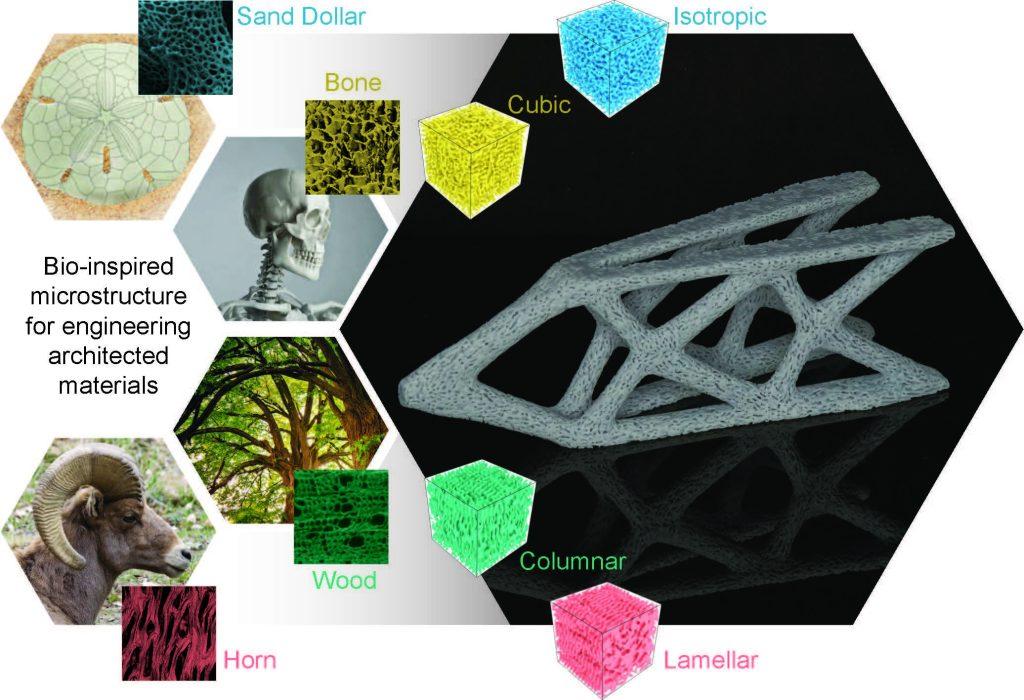China3D printingOn April 27, researchers at Princeton University and the Georgia Institute of Technology have designed a new, nature-inspired porous structure that can3D printing.
Based on materials such as bone and wood, the novel structure has special pores called spinodal microstructures that can be modified and fine-tuned to achieve a variety of part properties and behaviors. Objects incorporating these spinodal microstructures are typically lighter than their fully dense counterparts, while offering customizable stiffness curves.
The team has used SLA 3D printing to prototype several parts based on the spinodal microstructure, including facial implants and light aircraft engine components.
Davide Bigoni, professor at the University of Trento, said: “The authors have found an ingenious way to achieve continuous transitions between regions of different architectures. This is the ultimate concept of biomimicry, since all natural structures form a continuous system. This It’s a fact that has been known since ancient times – ‘natura non facit saltus’ – nature does not jump.”

Different kinds of pores found in bone, wood, and horns. Image via Princeton University.
Many structural materials in nature, such as bone, horn, and wood, are highly porous. In addition to making materials lighter, pores can also have specific functions, such as allowing fluids to pass through. In the case of bone, pores also contribute to the remodeling process, which can increase or decrease bone density in response to forces.
Therefore, the engineering community can greatly benefit from mimicking porous materials in nature, but developing synthetic materials with similar properties has historically been very challenging.
The Princeton team overcame this hurdle with the help of topology optimization techniques. This work is based on the basic premise that you can modify the microstructure of pores with different sizes, shapes and orientations, which ultimately means that performance can be tailored.
Specifically, the holes can be shaped like spheres, diamonds, cylinders, or lentils. By changing the shape and orientation of the holes, materials with different stiffness distributions can be loaded, while the size of the holes can be changed to control the density of the material.
“We have a very powerful technology that combines material architecture with optimization at different scales, combined with additive manufacturing,” said Glaucio Paulino, principal investigator on the project. “In the sense of scale, it can have a wide range of applications, so it can be applied to nano- and micro-technologies, as well as meso- and macro-scales.”
Facial Implants and Aircraft Parts
To test their newly designed microstructures in the field, the researchers first 3D printed prototypes of facial bone implants. Bone implants are usually made of porous titanium to support osseointegration, which allows bone to grow into the holes of the implant. But conventional implants do not offer the same customizability as the spinodal microstructure.
In this case, the team combined cylindrical and lentil-shaped holes to create an implant that was rigid enough to withstand chewing forces and porous enough to promote bone growth. Although the part is a prototype made of resin, it can also be 3D printed with biocompatible materials for end use cases.
“It’s not the base material that’s better. It’s the microscopic features that’s better,” added study co-author Emily Sanders. “Theoretically, we could make scaffolds out of any material — the most appropriate being to explore biocompatible materials.”
The team also 3D printed a spinodal jet engine bracket: a key aircraft component that is both strong and lightweight. In this case, the team was able to 3D print a smooth transition from one microstructure to another throughout the part, connecting the pore network without creating weak points in the microstructure. This ultimately leads to a more robust part design that is better suited to the application.

Bio-inspired 3D printed facial implants. Image via Princeton University.
As we’ve seen many times before, additive manufacturing can greatly benefit from imitating natural or other structures that already exist. Just this month, a Georgia Tech research project looked at how principles from the art of origami can be combined with 3D printing to design lightweight, flexible structures that can change shape. The work is expected to have applications in everything from 3D printed multifunctional robots to foldable RF components such as shape-shifting bridges and antennas.
Elsewhere, researchers at the Universities of Freiburg and Stuttgart have previously taken inspiration from the transmission mechanism of the air potato plant (Dymophora japonica) for 4D printing a wearable medical device that adjusts itself to a patient’s anatomy. Printing systems can be pre-programmed to perform complex movements when exposed to moisture.
(responsible editor: admin)


0 Comments for “New biomimetic microstructure paves way for 3D printed bone implants and jet engines”